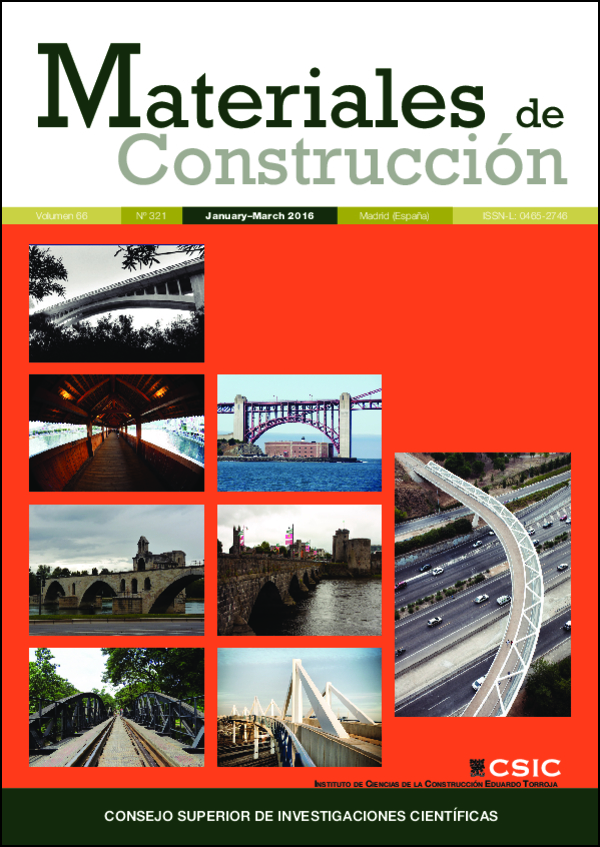Morteros de cemento basado en sedimentos marinos y polvo de concha de ostra
DOI:
https://doi.org/10.3989/mc.2016.01915Palabras clave:
Caracterización, Hidratación, Calorimetría, Mortero, DurabilidadResumen
En este trabajo se ha valorado la sustitución de cemento en morteros por sedimentos marinos dragados y polvo de concha de ostra (OS). Los sedimentos tienen altos contenidos de agua, cloruros, calcita, cuarzo, illita y caolinita como minerales principales. Los polvos OS están compuestos de carbonato cálcico y trazas de otras impurezas. Se añadieron a un cemento Portland, cuatro mezclas de los sedimentos y polvos de OS tratados a 650 °C y 850 °C en proporciones del 8%, 16% y 33% en peso. La hidratación de pastas se estudió a través de calorimetría. Se estudió además la porosidad accesible al agua, densidad aparente, permeabilidad al gas, resistencia a compresión y carbonatación acelerada. En general, un aumento en la adición produjo una reducción del rendimiento de los morteros. Se observó, sin embargo, una reducción de la permeabilidad a los gases con porcentajes de adición de hasta el 33%. Con valores del 16% de sustitución, mejoraron las resistencias mecánicas y la resistencia frente a la carbonatación.
Descargas
Citas
1. Lafhaj, Z.; Samara, M.; Boucard, L.; Agostini F.; Skoczylas, F. (2006) Polluted River Sediments: Characterization, Treatment and Valorization, Proceedings of the First Euro Mediterranean in Advances on Geomaterials and Structures, Hammamet, Tunisia.
2. Kribi, S.; Nzihou, A.; Sharrock, P.; Depelsenaire, G. (2005) Stabilization of Heavy Metals from Sediments Tailoring of Residue Properties, Proceedings of the Third International Conference on Remediation of Contaminated Sediments, Battelle Press, New Orleans, Louisiana, USA, January, ISBN: 1-57477-150-7.
3. Agostini, F.; Skoczylas, F.; Lafhaj, Z. (2007) About a possible valorisation in cementitious materials of polluted sediments after treatment. Cem. Concr. Compos. 29 [4], 270–278. http://dx.doi.org/10.1016/j.cemconcomp.2006.11.012
4. Lafhaj, Z.; Samara, M.; Agostini, F.; Boucard, L.; Skoczylas F.; Depelsenaire G. (2008) Polluted river sediments from the North region of France: Treatment with Novosol® process and valorization in clay bricks. Constr. Build. Mater. 22 [5], 755–762. http://dx.doi.org/10.1016/j.conbuildmat.2007.01.023
5. Kamali, S.; Bernard, F.; Abriak, NE.; Degrugilliers, P. (2008) Marine dredged sediments as new materials resource for road construction. Waste Management. 28 [5], 919–928. http://dx.doi.org/10.1016/j.wasman.2007.03.027 PMid:17826971
6. Agostini, F.; Davy, C.A.; Skoczylas, F.; Dubois, Th. (2010) Effect of microstructure and curing conditions upon the performance of a mortar added with Treated Sediment Aggregates (TSA). Cem. Concr. Res. 40 [11], 1609–1619. http://dx.doi.org/10.1016/j.cemconres.2010.07.003
7. Aouad, G.; Laboudigue, A.; Gineys, N.; Abriak, N.E. (2012) Dredged sediments used as novel supply of raw material to produce Portland cement clinker. Cem. Concr. Compos. 34 [6], 788–793. http://dx.doi.org/10.1016/j.cemconcomp.2012.02.008
8. Yoon, GL.; Kim, BT.; Kim, BO.; Han, SH. (2003) Chemical– mechanical characteristics of crushed oyster-shell. Waste Manage. 23 [9], 825–834. http://dx.doi.org/10.1016/S0956-053X(02)00159-9
9. Wang, HY.; Kuo, WT.; Lin CC.; Chen PY. (2013) Study of the material properties of fly ash added to oyster cement mortar. Constr. Build. Mater. 41, 532–537. http://dx.doi.org/10.1016/j.conbuildmat.2012.11.021
10. Yang, EI.; Yi ST.; Leem, YM. (2005) Effect of oyster shell substituted for fine aggregate on concrete characteristics: Part I. Fundamental properties. Cem. Concr. Res. 35 [11], 2175–2182. http://dx.doi.org/10.1016/j.cemconres.2005.03.016
11. Yang, EI.; Kim, MY.; Park, HG.; Yi S.T. (2010) Effect of partial replacement of sand with dry oyster shell on the long-term performance of concrete. Constr. Build. Mater. 24 [5], 758–765. http://dx.doi.org/10.1016/j.conbuildmat.2009.10.032
12. Dang, T.A. (2011) Valorisation durable des sédiments marins Bretons comme matériaux de construction, Thèse de Doctorat–INSA Rennes.
13. Dang, T.A.; Kamali, S.; Prince, W.A. (2013) Design of new blended cement based on marine dredged sediment. Constr. Build. Mater. 41, 602–611. http://dx.doi.org/10.1016/j.conbuildmat.2012.11.088
14. EN 196-1, (2006) European standard, methods of testing cement–Part 1: Determination of strength. NF EN 196-1.
15. AFREM Group, « Les résultats des essais croises AFREM pour la determination de la masse volumique apparente et de la porosité accessible à l'eau des bétons ».
16. Care, S.; Derkx, F. (2011) Determination of relevant parameters influencing gas permeability of mortars. Constr. Build. Mater. 25 [3], 1248–1256. http://dx.doi.org/10.1016/j.conbuildmat.2010.09.028
17. Hamami, A.A.; Turcry, Ph.; Aït-Mokhtar, A. (2012) Influence of mix proportions on microstructure and gas permeability of cement pastes and mortars. Cem. Concr. Res. 42 [2], 490–498. http://dx.doi.org/10.1016/j.cemconres.2011.11.019
18. Lagier, F.; E. Kurtis, K. (2007) Influence of Portland cement composition on early age reactions with metakaolin. Cem. Concr. Res. 37, [10] 1411–1417. http://dx.doi.org/10.1016/j.cemconres.2007.07.002
19. Rahhal, V.; Cabrera, O.; Talero, R.; Delgado, A. (2007) Calorimetry of portland cement with silica fume and gypsum additions. J. Therm. Anal. Calor. 87, 331–336. http://dx.doi.org/10.1007/s10973-005-7324-1
20. Rahhal, V.; Talero, R. (2009) Calorimetry of Portland cement with silica fume, diatomite and quartz additions. Constr. Build. Mater. 23 [11], 3367–3374. http://dx.doi.org/10.1016/j.conbuildmat.2009.06.003
21. Rahhal, V.; Talero, R. (2008) Calorimetry of Portland cement with metakaolins, quartz and gypsum additions. J. Therm. Anal. Calor. 91, 825–834. http://dx.doi.org/10.1007/s10973-006-8250-6
22. Christensen, A.N.; Jensen, T.R.; Hanson, J.C. (2004) Formation of ettringite, Ca6Al2(SO4)3(OH)12.26H2O, AFt, and monosulfate, Ca4Al2O6(SO4) .14H2O, AFm-14, in hydrothermal hydration of Portland cement and of calcium aluminum oxide–calcium sulfate dihydrate mixtures studied by in situ synchrotron X-ray powder diffraction. Journal of Solid State Chemistry. 177 [6], 1944–1951. http://dx.doi.org/10.1016/j.jssc.2003.12.030
23. Ez-zaki, H.; Diouri, A.; Kamali, B.S.; Dang, T.A.; Sassi, O.; Bernard, F. (2013) Properties and hydration behavior of blended clinker and Portland-sediment cement pastes. Chemistry and Materials Research 5, 121–127.
24. Bentz, D.P.; Haecker, C.J. (1999) An argument for using coarse cements in high-performance concretes. Cem. Concr. Res. 29 [4], 615–618. http://dx.doi.org/10.1016/S0008-8846(98)00201-4
25. Gallé, C. (2001) Effect of drying on cement-based materials pore structure as identified by mercury intrusion porosimetry. A comparative study between oven-, vacuum-, and freeze-drying. Cem. Concr. Res. 31 [10], 1467–1477. http://dx.doi.org/10.1016/s0008-8846(01)00594-4
26. Sanjuán, M.A.; Mu-oz-Martialay R. (1996) Oven-drying as a preconditioning method for air permeability test on concrete, Mater. Lett. 27 [4–5], 263–268. http://dx.doi.org/10.1016/0167-577X(95)00283-9
27. Noumowé, A.N.; Clastres, P.; Debicki, G.; Costaz, J-L. (1996) Thermal stresses and water vapour pressure of High Performance Concrete at High Temperature. 4th International Symposium on Utilization of High-strength/ High-performance concrete, Paris, May.
28. EN 197-1, (2001) European standard, cement–Part 1: Composition, specifications, and conformity criteria. NF EN 197-1.
Publicado
Cómo citar
Número
Sección
Licencia
Derechos de autor 2016 Consejo Superior de Investigaciones Científicas (CSIC)

Esta obra está bajo una licencia internacional Creative Commons Atribución 4.0.
© CSIC. Los originales publicados en las ediciones impresa y electrónica de esta Revista son propiedad del Consejo Superior de Investigaciones Científicas, siendo necesario citar la procedencia en cualquier reproducción parcial o total.
Salvo indicación contraria, todos los contenidos de la edición electrónica se distribuyen bajo una licencia de uso y distribución “Creative Commons Reconocimiento 4.0 Internacional ” (CC BY 4.0). Consulte la versión informativa y el texto legal de la licencia. Esta circunstancia ha de hacerse constar expresamente de esta forma cuando sea necesario.
No se autoriza el depósito en repositorios, páginas web personales o similares de cualquier otra versión distinta a la publicada por el editor.
















